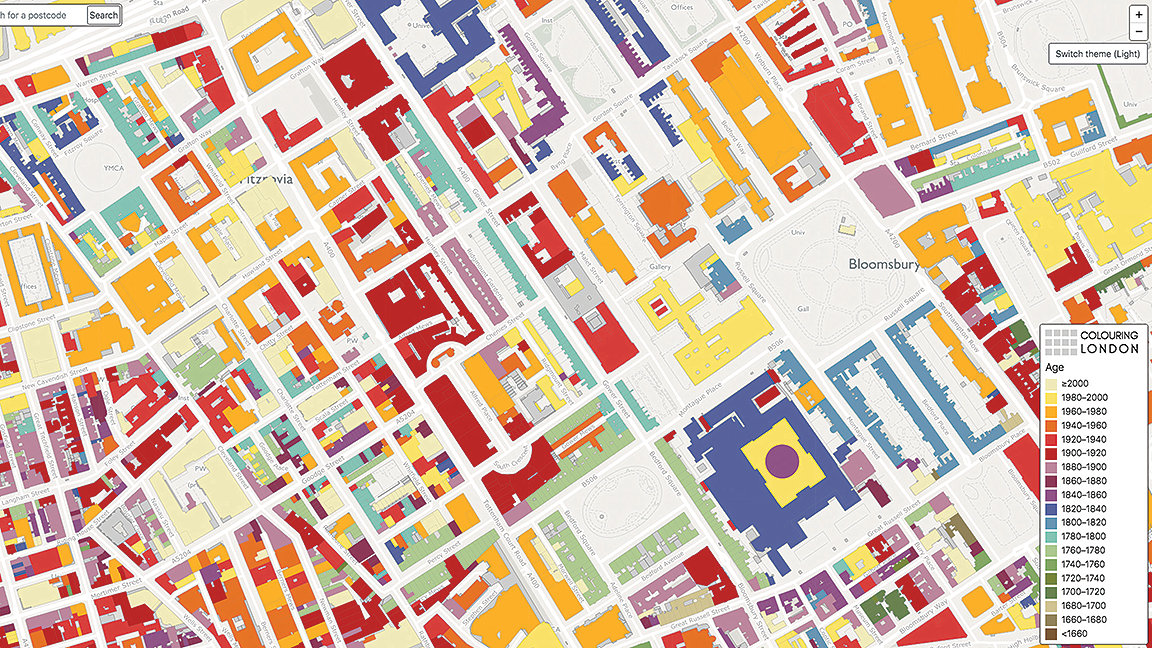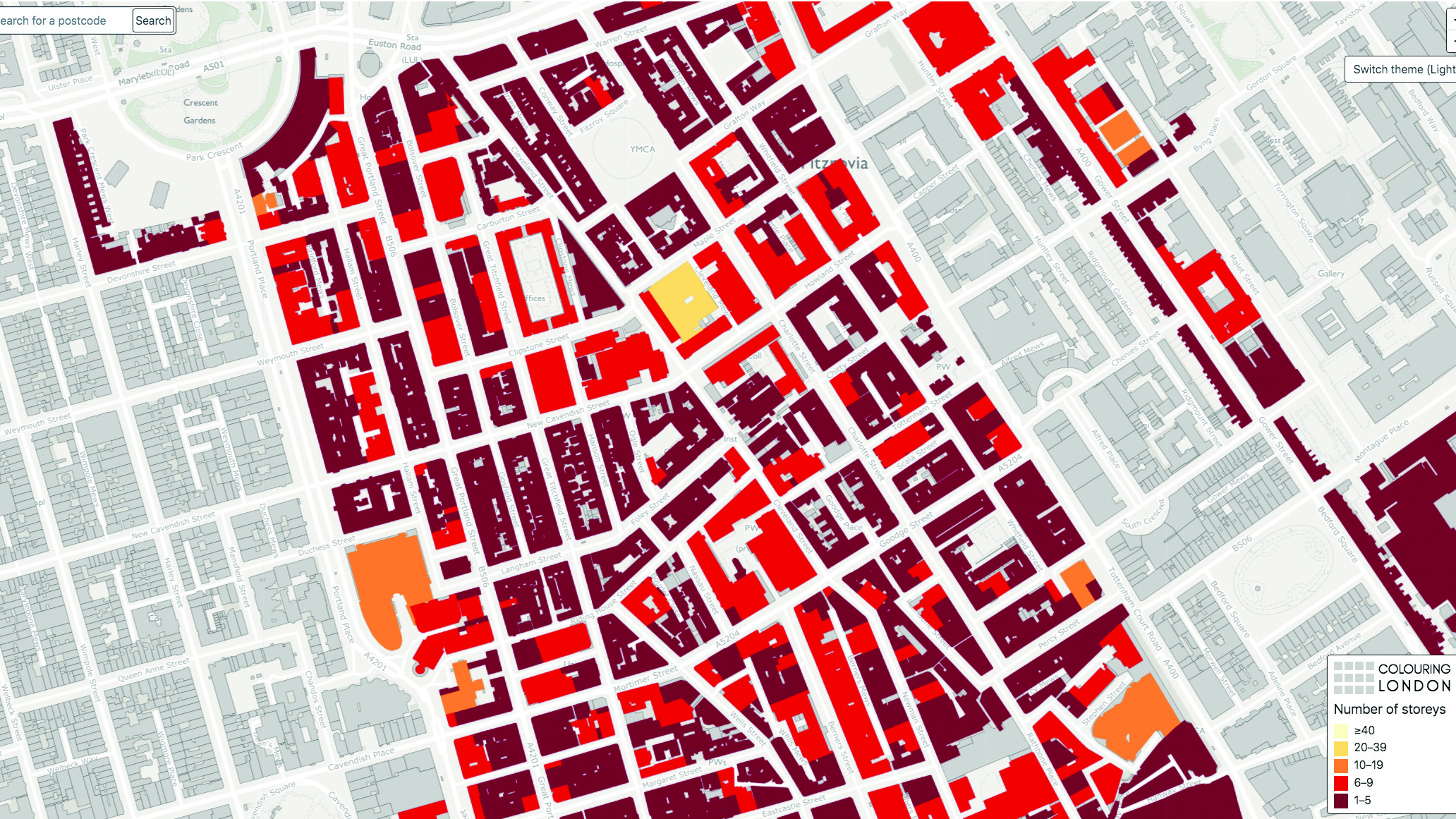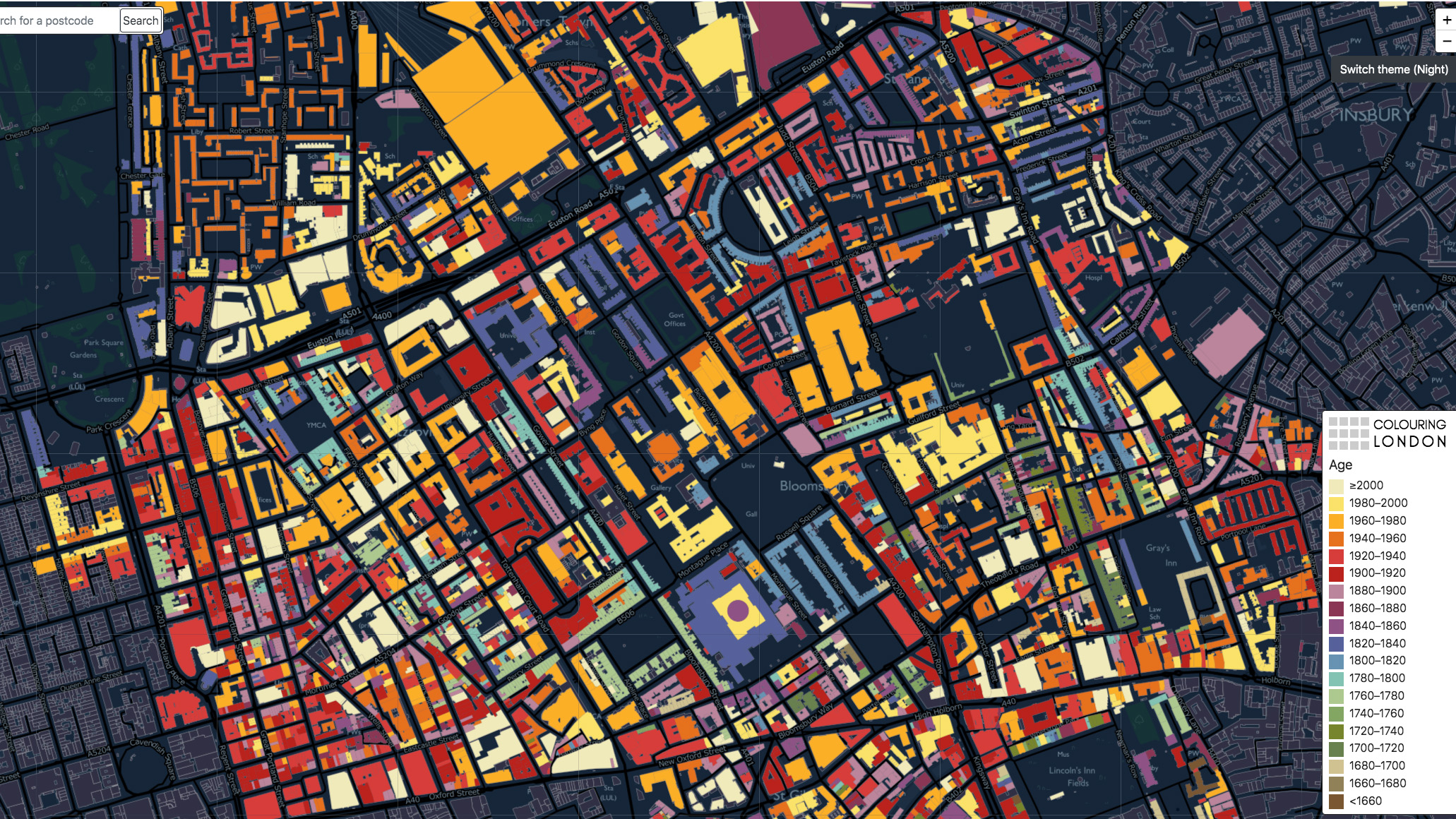
Colouring London platform screengrab shows the age of buildings in the Bloomsbury and Fitzrovia areas of London
What type of buildings make up our cities? What size and shape are they? How old are they and how are they used? How are they built? How energy-efficient are they? How long are they likely to last? Are some building types likely to be more resilient or vulnerable than others, and if so why?
Answering questions such as these is increasingly important in the development of strategies to maximise cities' efficiency and sustainability, and measure and monitor their long-term performance. At the same time, there is now an opportunity to exploit advances in computing to model potential planning and energy scenarios much more accurately. However, in the UK, the statistical data sets that are necessary to build such models and deal with basic questions on the stock continue to be highly fragmented, and in many cases restricted, unverified and incomplete.
Building stock is the principal physical component of cities, with the value of land intrinsically linked to the quality of the built environment. It is also where the greatest potential for energy reduction lies, with buildings and the construction sector responsible for 36 per cent of global energy consumption and nearly 40 per cent of carbon dioxide emissions, according to the International Energy Agency.
Since the 1990s, the energy agenda has prompted a shift in the European construction industry from focusing on new buildings to building re-use, leading to an urgent demand for granular data on older buildings and urban stock as a whole. It has also shown how little is currently known by urban scientists about these slow-moving systems and their operation, and highlighted the need for investment in relevant analysis and data.
'There is now an opportunity to exploit advances in computing to model potential planning and energy scenarios much more accurately'
UK lags behind
Outside the UK, governments are increasingly releasing comprehensive, open-source building attribute data for cities. The Dutch agency Kadaster, for example, publishes building attribute data including age and function. Any user can link this to detailed building geometry data to produce high-quality, colour-coded building attribute maps for any Dutch city or town. In the USA, many cities have also published open-source property tax data sets and building footprints since 2013.
However, despite growing pressure, the release of comprehensive open data on the UK's building stock has been painfully slow. Although the Treasury has now announced plans to open up Ordnance Survey's MasterMap footprint data, the country's most comprehensive building attribute database, the property tax database run by the Valuation Office Agency remains heavily restricted. Unless something is done soon, the UK will fall behind those countries releasing open building attribute data in many areas of urban research.
The Bartlett Centre for Advanced Spatial Analysis (CASA) at University College London has therefore partnered with Ordnance Survey, the Greater London Authority and Historic England to develop an open-data platform called Colouring London. This is designed to collect, collate, visualise and disseminate statistical attribute data on every building in the city and, by 2021, to become the first port of call for open data on London's building stock. The platform code is also open and available to any city to use.
Key to the success of the project will be the ability of CASA's online system to support high-quality data flows, both as uploads to the database and downloads from it for use in multiple applications. To do this, the platform not only needs to source, secure and visualise large-scale, fragmented data sets, but also to tap into the vast body of specialist knowledge held by the so-called crowd of residents, community-led planning groups, amenity societies, conservation bodies and built environment professionals.
As part of this process, CASA is currently working with RICS and other professional bodies on subcategories, standards and metrics, as well as ideas for additions and improvements. Subject specialists are key to the success of crowdsourcing platforms, so CASA is looking at ways to encourage and acknowledge the involvement of individuals. A network of contributors interested in extracting information on the dates of construction and demolition of buildings is also being developed.
- location
- use
- type
- age and history
- size and shape
- construction
- team
- sustainability
- street block and environment
- community
- planning
- 'Like me?' – that is, whether users think the building benefits the city.
'Colouring London is designed to collect, collate, visualise and disseminate statistical attribute data on every building in the city'


Each core category is accompanied by a brief explanation of why the data is needed, along with tips on sources for those wishing to help colour in the maps. A key question for CASA is what other subcategories should be added: should we, for example, consider a repairability rating or an embodied carbon measure? Another of the project's challenges is how to help users assess the data's reliability. For this we are working to add a range of support features, including edit histories, sources and verification tools.
When a user edits a building's entry and adds data, the colour of the building footprint changes; for example, under the age category, a building constructed between 1980 and 2000 will be yellow, while under size and shape a building of ten to 19 storeys high is orange.
Colour is fundamental to the project, not only in terms of the visualisation of data categories but also as a way to acknowledge each contribution. The idea is to stimulate users' curiosity to reveal, and update, the form of the city alongside other volunteers, using a simple gamification approach.
As well as collecting building attribute data, Colouring London aims to increase transparency in the planning system and to help boost building standards and support performance monitoring. The 'Like me?' category is designed to help London's planning departments to collect important information on building performance that would otherwise be difficult to access, and to identify buildings that may be key, local socio-economic assets in future.
Furthermore, it enables the platform to harness the predictive ability of heritage and community planning groups that, in the 1960s and 70s, foresaw the socio-economic potential of now iconic, high-value areas of London, such as Covent Garden, Shoreditch, Whitehall and Bloomsbury and sought to preserve them. In turn, this will allow the city to promote high-quality construction and design.
Related competencies include: GIS (geographical information systems), Spatial planning policy and infrastructure, Surveying and mapping
Further information: Colouring London launches in October. To see maps, add data or contribute to discussion threads, please visit colouringlondon.org
